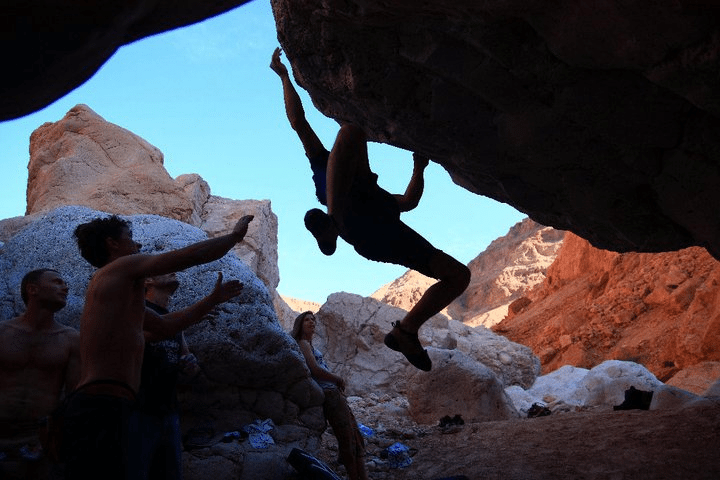
True backpacking can be a real challenge in itself, but occasionally some dare to take it to the next level; rock-climbing. In addition to so many beautiful places there are to hike in North America, people like Matthew Oberhardt have decided to take advantage of every rugged section of a mountain. I was curious to find out more about this sport, so I sat down with Matt to discover a little more information about rock-climbing in the backcountry:
 Is there anywhere in particular you would recommend rock-climbing, and for all levels?
Is there anywhere in particular you would recommend rock-climbing, and for all levels?
If you ask most climbers about the best spots in the US, they will automatically think Westward, to meccas like Yosemite, Bishop, or areas around Boulder, Colorado. The climbing out west is spectacular. However, I’m from the Southeast, and I have a bit of home pride. North Carolina, Tennessee, West Virginia, and even Alabama offer world class spots. Whether you’re a beginner or an expert, you can find enough climbs in this region to last a lifetime.
Do you have any tips you could offer on becoming a rock-climber?
Nowadays, most climbers start out in a climbing gym. I think this is a fantastic and easy way to get into the sport. Trendy spots are opening up in most major cities, and nearly all gyms will offer beginner classes in safety and technique to get you going. Try it out with a friend. If you enjoy it, you can then take a short class to learn the safety basics. Rock climbers are mostly relaxed and inclusive people, so if you stick around for a while, you’ll probably find yourself making friends, and eventually being invited to climb outdoors.
What are some of your favorite spots to climb? Why?
I have a few favorites. For long routes that take multiple hours to get up, I prefer Squamish, British Columbia. The main attraction is the Stawamus Chief, a 2300 foot granite monolith that looms over both the town and the surrounding rainforest. You can have a great coffee in town in the morning, spend a whole day up on the rock, and then be down in the brewpub the same evening for a hearty meal.
If I’m in the mood for shorter routes that can be climbed in a single rope length, I prefer the New River Gorge, in West Virginia. The area hosts a unique type of rock called Nuttall sandstone, which forms intricate and often inspiring challenges. Finally, if I’m out for a day of bouldering (i.e., 10-15 foot climbs where you use crash pads instead of ropes for safety), I love an area called Stone Fort, in Chattanooga Tennessee. The movement there is incredibly aesthetic, and I always have an amazing time.
 What tools and equipment are necessary to be safe? Not just for climbing, but in general?
What tools and equipment are necessary to be safe? Not just for climbing, but in general?
Beginning climbing gear includes a harness, climbing shoes, a chalk bag, and a belay device (with a carabiner). All of this can be purchased for a little over $150. There is more gear necessary for setting up ropes outdoors, but I would recommend buying that later, after you’ve already gone a number of times and learned from experienced friends or a guide.
Whenever you go out, you should bring a headlamp. Climbing trips often leave you out in the woods at night and you need to be able to hike at night safely. Other than that, normal outdoor rules apply. Bring plenty of water (3-4 liters in summer, 1.5-2 liters in winter), lunch, snacks, a warm shirt or hoodie (or a down jacket if it’s going to be cold), decent shoes that can handle the hike, and clothes you can move in. I usually climb in pants, even in summer, so I don’t scrape up my legs or get poison ivy, but that’s just my preference.
What are some major risks to look out for?
More dangerous even than you falling is the chance of a rock falling on you. Remember, if you’re at the base of an outdoor cliff, there might be rocks at the top that aren’t too secure. Animals, ropes, or even a climber can break or dislodge a rock, and folks at the bottom can become victims. Always wear a helmet at the base of a cliff, unless you’re certain there’s nothing loose on top of it.

What does it feel like to climb? What inspired you to take up the sport?
I love the movement and I love being out in nature. Boulder problems are like puzzles; they can seem impossible to solve at first, but little by little you’ll make inroads, until finally you break through get to the top. I love that process. There’s also a beauty to flowing up a rock, out in the woods, with nothing but the breeze to contend with. These two aspects of the sport make it deeply fulfilling.
What advice would you have for new climbers?
Don’t force it. If you try it and like it, then start going to the gym regularly and

everything will sort itself out. If you try it and it’s not for you, then don’t fight too hard. Most people I know who’ve gotten into climbing love it from the get-go. There’s something about it that clicks with some people, and not with others. If it’s for you, you’ll know.
Matt is just settling back into the East Coast of America after living a few years in Tel Aviv, Israel, where he fell in love with hummus and with long, Mediterranean summers. When he’s not doing research on bacterial food preferences, he’s usually out finding rocks to climb, sitting in cafes with friends, or, when the mood strikes him, writing. He currently lives in Washington, DC. Check out his blog from his days in Tel Aviv: mattointelaviv.blogspot.com.













